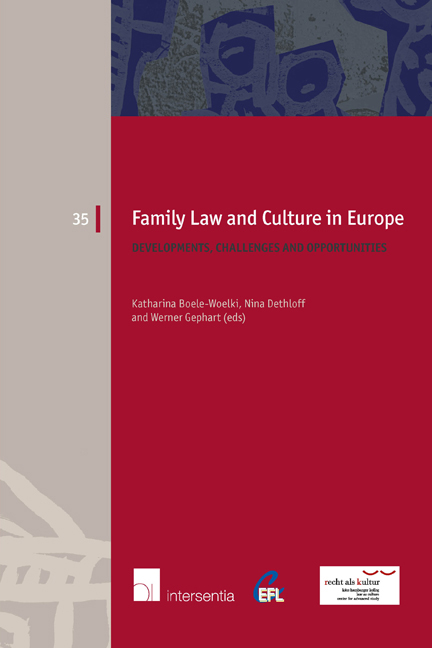Book contents
- Frontmatter
- Preface
- Contents
- List of Authors
- PART ONE THE CEFL PRINCIPLES ON PROPERTY RELATIONS BETWEEN SPOUSES
- PART TWO BREAKUP OF (NON-)FORMALISED RELATIONSHIPS
- Statutory Regulation of Cohabiting Relationships in the Nordic Countries: Recent Developments and Future Challenges
- Legislating for Cohabitation in Common Law Jurisdictions in Europe: Two Steps Forward and One Step Back?
- The Swedish Cohabitees Act in Today's Society
- Maintenance between Former Spouses and Gender Equality
- Collaborative Practice: An Interdisciplinary Approach to the Resolution of Confl ict in Family Law Matters
- PART THREE NEW CONCEPTS OF PARENTAGE
- PART FOUR INTERNATIONAL FAMILY RELATIONSHIPS
- PART FIVE TRANSNATIONAL FAMILIES: ACROSS NATIONS AND CULTURES
- EUROPEAN FAMILY LAW SERIES
Statutory Regulation of Cohabiting Relationships in the Nordic Countries: Recent Developments and Future Challenges
from PART TWO - BREAKUP OF (NON-)FORMALISED RELATIONSHIPS
Published online by Cambridge University Press: 22 November 2017
- Frontmatter
- Preface
- Contents
- List of Authors
- PART ONE THE CEFL PRINCIPLES ON PROPERTY RELATIONS BETWEEN SPOUSES
- PART TWO BREAKUP OF (NON-)FORMALISED RELATIONSHIPS
- Statutory Regulation of Cohabiting Relationships in the Nordic Countries: Recent Developments and Future Challenges
- Legislating for Cohabitation in Common Law Jurisdictions in Europe: Two Steps Forward and One Step Back?
- The Swedish Cohabitees Act in Today's Society
- Maintenance between Former Spouses and Gender Equality
- Collaborative Practice: An Interdisciplinary Approach to the Resolution of Confl ict in Family Law Matters
- PART THREE NEW CONCEPTS OF PARENTAGE
- PART FOUR INTERNATIONAL FAMILY RELATIONSHIPS
- PART FIVE TRANSNATIONAL FAMILIES: ACROSS NATIONS AND CULTURES
- EUROPEAN FAMILY LAW SERIES
Summary
THE REASON FOR SHARING ASSETS UPON A RELATIONSHIP BREAKDOWN
Whereas the marital property regimes are quite similar in the Nordic countries, the legal response to cohabitating relationships differs greatly among these countries. Sweden is the only country where assets can be divided equally upon termination. In the other countries, compensation or restitution may be granted according to different rules. This differing approach might come as a surprise, as socio-demographic characteristics are more or less the same in all five countries.
One characteristic of the Nordic countries’ labour force is the high participation of women, while at the same time there is a high fertility rate. The institution of the lifelong housewife is definitely a thing of the past. However, complete gender equality has not been achieved in the Nordic countries, since about 40 per cent of employed women are working part time, while very few men work part time. A large number of women in the Nordic countries continue to assume the main responsibility for childcare; they oft en earn less than their partners and, as a result, have little surplus income to invest. This fact – in my opinion – is the core of the rationale in favour of legislation pertaining to the termination of cohabiting relationships: many cohabitants – albeit far from all of them – live as financially interdependent entities, especially if the relationships have lasted for a period of several years and the couples have children. Together, they form a work unit, as well as a consumption and investment unit, and for these reasons the financial position of one party can hardly be unaffected by that of the other. The most typical example of this is when one cohabitant undertakes more than her (or his) share of the ‘unprofitable’ tasks in the family, such as childcare and the coverage of consumption expenses, and as a result ends up with no appreciable assets even after a longer cohabitating relationship. By taking on more than her share of the non-profitable tasks, she has enabled part of her partner's income to accrue, and if that income is used for investments she has contributed indirectly to the other's accumulation of capital.
- Type
- Chapter
- Information
- Family Law and Culture in EuropeDevelopments, Challenges and Opportunities, pp. 65 - 76Publisher: IntersentiaPrint publication year: 2014



